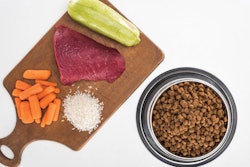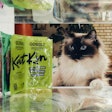
The grain-free pet food market changed rapidly in July 2018, when U.S. Food and Drug Administration Center for Veterinary Medicine officials alerted pet owners about reports of canine dilated cardiomyopathy (DCM) in dogs eating certain dog foods containing peas, lentils, other legume seeds or potatoes as main ingredients.
“Some companies were pointed out by FDA, which was very surprising to me,” he said. “Without all the total scientific background, they were pointing out companies and grains and non-grain foods,” Serge Boutet, animal nutrition consultant, SB Nutrinnov Consultants, said during his Petfood Essentials: CONNECT-ED educational short course.
FDA’s widely publicized announcement negatively affected grain-free brands’ sales, especially for those brands FDA named in June 2019. However, the investigation did inspire renewed interest in grains spurring new product development, Boutet said. To avoid DCM and future problems, pet food formulators may need to reevaluate what humanization means in terms of ingredient diversity.
Dog food formulation trends after FDA announcement
Manufacturers told Boutet that they needed to move away from grain-free formulations, he said, suddenly reversing a years-long trend. The gravitas of the FDA influenced pet owners to take the announcement seriously. This wasn’t an irate blogger, this was the United States federal government. Despite the disruption for some pet food brands, suppliers and even farmers, others in those industries benefited from the sudden interest in grains of various types.
“It brought back a little bit of the positiveness of grains,” Boutet said.
The return of grains to pet foods makes sense to Boutet, considering their status in human food, the ultimate model for many pet foods now.
“When you go to your grocery store look at the aisles of breakfast cereals and the aisle of breads. And what do you see?” he said. “Wheat, grain, nine-grains, 10-grains, 14-grains, two-grains.”
Humans look for a variety of grains, and a variety of ingredients in general. The human diet is extremely varied, he said. Limiting pets to a few ingredients has always seemed fraught with peril to Boutet. Instead, he recommends blending a wide range of nutritious ingredients.
Following the FDA announcements, various types of grain-in pet foods appeared, marketed as grain friendly, ancient grains or focusing on which ingredients were not included, like peas or potatoes. Along with bringing grains back into pet food, the FDA investigation fueled a wave of reformulations to address DCM. One of those brands, Acana made by Champion Petfoods, was reformulated to include taurine and fed to Labrador Retrievers for nearly seven months, the dogs didn’t show physiological changes that scientists believe may accompany DCM. The journal Translational Animal Science published the results.
“I am doing like a lot of formulators are doing as well, I'm adding methionine, taurine and sometimes lysine to formulas, as pure amino acids,” Boutet said. “Just as a little insurance policy because, you know, science may discover new things.”
Ingredient diversity in dog food
While scientists may eventually uncover the epidemiology behind the DCM cases, federal researchers have found the situation to be complex. In a late September meeting, academics, industry representatives and veterinary medicine scientists joined FDA officials the to discuss the agency’s DCM investigation. Ultimately, the agency concluded that no direct causality appeared among the diets and the disease.
“FDA is backing off a little bit, smoothly, because it's more complex than what they think,” Boutet said. “I'm not afraid to share what I'm thinking about this situation. It's related a lot to the pressure from the hyper-humanization.”
Pet owners want to feed their pets like themselves, with a limited range of wholesome ingredients, but people often underestimate how varied their own diets are, he said. Likewise, people don’t think about the fact that their dogs may eat a specific kibble every day for every meal, while few humans follow a similar monotonous diet.
“Think about what we eat, make the list of ingredients of what you eat, in a week, a month, a year,” Boutet said. “The list of ingredients will be so huge. The complementarity of ingredients is very important.”















